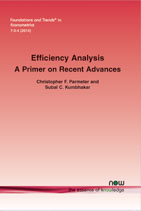Efficiency Analysis: A Primer on Recent Advances
By Christopher F. Parmeter, Department of Economics, University of Miami, USA, cparmeter@bus.miami.edu | Subal C. Kumbhakar, Department of Economics, State University of New York, kkar@binghamton.edu
Abstract
This monograph reviews the econometric literature on the estimation of stochastic frontiers and technical efficiency. Special attention is devoted to current research.
Efficiency Analysis
Efficiency Analysis details the important econometric area of efficiency estimation, both past approaches as well as new methodology. There are two main camps in efficiency analysis: that which estimates maximal output and attributes all departures from this as inefficiency, known as Data Envelopment Analysis (DEA), and that which allows for both unobserved variation in output due to shocks and measurement error as well as inefficiency, known as Stochastic Frontier Analysis (SFA). This volume focuses exclusively on SFA.
The econometric study of efficiency analysis typically begins by constructing a convoluted error term that is composed on noise, shocks, measurement error, and a one-sided shock called inefficiency. Early in the development of these methods, attention focused on the proposal of distributional assumptions which yielded a likelihood function whereby the parameters of the distributional components of the convoluted error could be recovered. The field evolved to the study of individual specific efficiency scores and the extension of these methods to panel data. Recently, attention has focused on relaxing the stringent distributional assumptions that are commonly imposed, relaxing the functional form assumptions commonly placed on the underlying technology, or some combination of both. All told exciting and seminal breakthroughs have occurred in this literature, and reviews of these methods are needed to effectively detail the state of the art.
The generality of SFA is such that the study of efficiency has gone beyond simple application of frontier methods to study firms and appears across a diverse set of applied milieus. This review should appeal to those outside of the efficiency literature seeking to learn about new methods which might assist them in uncovering phenomena in their applied area of interest.
